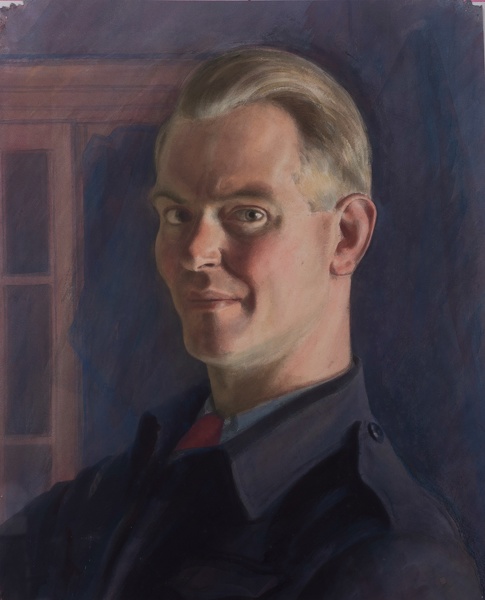
£2,500
Self Portrait
Framed (ref: 7654)
Pastel
Tags: Hubert Arthur Finney pastel Portrait men war 1.H.A.Finney 1.PORTRAIT OF AN ARTIST World War II Paintings by British Artists

Tags: Hubert Arthur Finney pastel Portrait men war 1.H.A.Finney 1.PORTRAIT OF AN ARTIST World War II Paintings by British Artists
Provenance: The Artist's Family
Exhibited: The Lightbox, Woking, Out of the Shadows, 2020, cat 6; WW2 - War Pictures by British Artists, Morley College London, 28 October -23 November 2016, cat 147.
Literature: WW2 - War Pictures by British Artists, Edited by Sacha Llewellyn & Paul Liss, July 2016, cat 147, page 188.
Llewellyn, Sacha, and Paul Liss. Portrait of an Artist. Liss Llewellyn, 2021, p.315.
During the war Finney served in the Ambulance Crews of the Air Raid Precautions Service, later named Civil Defence, for a period of four years until in 1945 he got pleurisy. The Civil Defence uniform consisted of blue dungarees with the ARP badge on their left breast.
In this self portrait Finney wears a red tie - suggesting that it dates to 1945 he was convalescing (red ties had been used since the First World War to show that the wearer was ill or wounded and that he was a Serviceman). Indeed in his unpublished autobiography Finney records that towards the end of the war: My health was beginning to show signs of breaking and I was sent to a Civil Defence Convalescent house after a serious bronchial cold. I never ceased to draw and paint and I presented one painting to the Convalescent Home before I left. I also painted a ceiling in a municipal theatre and the back stage in the depot of Kinston House and held a drawing class one evening a week for the Ambulance and Rescue Service Personnel.
In addition to the red tie hospital clothing consisted of a dark blue serge military type suit, grey or greyish-blue shirt.

The Rescue Services - Heavy and Light - were Auxiliary Services that worked in close co-operation with the National Fire Service and the Auxiliary Fire Service. The latter put out the fires and the former searched the wreckage of damaged buildings in order to rescue anyone who might be trapped or to remove the bodies of those who had been killed in a raid. Some of this could be done manually (Light Branch), but heavy equipment - cranes etc - was required if major collapses had taken place (the Heavy Branch). Debris also had to be cleared off the streets in order that the life of the town/city could return, as near as possible, to normal as soon as possible. Essentially theirs was a clearing up job after having done their best to extricate casualties or victims.
We are grateful to Andrew Cormack and Nicholas Finney for assistance